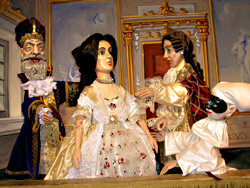Cinderella
Kids love puppets. And judging by the recent spate of reality television shows featuring transformation of both body and home, adults love makeovers. What then to better strengthen the parent/child bond than an outing to Northwest Puppet Center to view a well-timed production of Cinderella, or as the Italians would have it, Cenerentola. The present version, performed by the Carter Family Marionettes, is based on a 19th century Venetian puppet script and includes a few variations on the old standard to keep those who think they know the story inside and out on their toes: Unusual characters such as Moby Dick and a magic dove are surprising additions, and an unorthodox battleship scene is perhaps the briefest ever staged. While the puppets’ acting may justifiably be termed “wooden,” who can blame them? After the show kids have an opportunity to meet the stars of the production and visit the lobby where a host of marionettes and puppet theatre sets are on display. There are both real and imaginary strings attached to this family date: not to be considered a one-night affair, children will likely demand future commitments. But NPC’s varied 2006 performance schedule should provide something for everyone, not least a welcome escape from the “reality” of television. Northwest Puppet Center, 9123 15th Avenue N.E., 206-523-2579, www.nwpuppet.org. $7.50 – $9.50. 7:30 p.m Fri., 1 & 3 p.m. Sat.-Sun. Ends Jan. 29. SUZANNE BEAL
Richard Alston Dance Company
The U.S. and Great Britain may be two countries divided by a common language, but Richard Alston’s work will look very familiar, and very beautiful, to eyes that know American modern dance. With roots in both Martha Graham’s and Merce Cunningham’s styles, Alston went on to forge a personal aesthetic that values the articulate range of ballet and the cool integrity of post-modern dance, with an ongoing curiosity about musicality. He is not intimidated by complex scores, creating analogs in his choreography’s rich kinetic flow. Although his work is not yet well known here, his companies have spawned many of the artists working in Britain today, while he himself has continued to generate a legacy of dances that critics have called “exquisite balm for tired eyes.” Meany Theater, University of Washington, 206-543-4880, www.meany.org. $38. 8 p.m. Thurs. Jan. 19-Sat. Jan. 21. SANDRA KURTZ
Seattle Opera
No doubt many fans wondered why Seattle Opera’s Speight Jenkins cast Wagnerian mega-soprano Jane Eaglen as the female lead in Strauss’ bubbly operetta Die Fledermaus. But in one way at least Eaglen is ideal as the flighty Rosalinde: Her voice is renowned not only for size but ease; she opens her mouth, and sound streams out. She is, in fact, one of the few cast members in this production who isn’t working harder than necessary, vocally or physically, for comic effect. Spoken dialogue is always an issue for opera singers: Eaglen handles hers imaginatively, giving her own natural British accent a splendidly actressy spin as Rosalinde, then pitching it up an octave in her ball-night disguise as a breathy Hungarian countess. With elegantly energetic comic turns by her fellow Wagnerians Richard Berkeley-Steele (as Rosalinde’s erring husband) and Alan Woodrow (as her would-be lover Alfred), and six naughty can-can dancers imported from The Merry Widow, it adds up to a delectable, if slightly strenuous, show. McCaw Hall, Seattle Center, 206-389-7676, www.seattleopera.org. $48-$134. Various days and times. Ends Sat. Jan. 28. GAVIN BORCHERT




